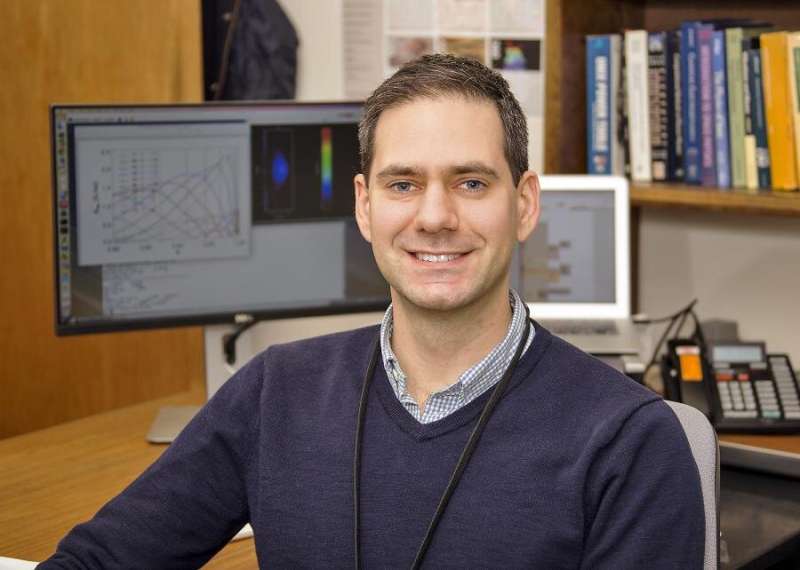Improving the magnetic bottle that controls fusion power on Earth

Scientists who use magnetic fields to bottle up and control on Earth the fusion reactions that power the sun and stars must correct any errors in the shape of the fields that contain the reactions. Such errors produce deviations from the symmetrical form of the fields in doughnut-like tokamak fusion facilities that can have a damaging impact on the stability and confinement of the hot, charged plasma gas that fuels the reactions.
Researchers led by scientists at the U.S. Department of Energy's (DOE) Princeton Plasma Physics Laboratory (PPPL) have found clear evidence of the presence of error fields in the initial 10-week run of the National Spherical Torus Experiment—Upgrade (NSTX-U), the flagship fusion facility at the laboratory. The exhaustive detection method they used could provide lessons for error correction in future fusion devices such as ITER, the large international fusion facility under construction in France to demonstrate the practicality of controlled fusion energy.
Fusion powers the sun and stars
Fusion, the power that drives the sun and stars, is the fusing of light elements in the form of plasma—the hot, charged state of matter composed of free electrons and atomic nuclei—that generates massive amounts of energy. Scientists around the world are seeking to replicate fusion on Earth for a virtually inexhaustible supply of power to generate electricity.
At PPPL, researchers have put together a combination of experimental data, detailed measurement of the position of the magnets, and computer modeling of the response of the plasma to locate the source of the NSTX-U error fields. The analysis uncovered a spectrum of small error fields—an inevitable result of the fact that a tokamak cannot be perfectly symmetrical—but most had an easily correctible impact on the plasma. However, one major find stood out: a slight misalignment of the magnetic coils that run down the center of the tokamak and produce the fields that wrap horizontally—or "toroidally"—around the interior of the vessel.
The clue scientists sought
This misalignment was the clue the scientists had sought. "We looked for the source of the error with the biggest impact on the plasma," said physicist Nate Ferraro, first author of the research that reported the search and discovery in Nuclear Fusion. "What we found was a small misalignment of the center-stack coils with the casing that encloses them."
The slight misalignment generated errors that resonated in the behavior of the plasma. Among the issues was a braking and locking effect that kept the edge of the plasma from rotating, and increased localized heating on plasma-facing components inside the tokamak.
Discovery of the misalignment followed shut-down of the tokamak for ongoing repairs in the wake of a coil failure. The misalignment findings are now being used "to drive new engineering tolerance requirements for NSTX-U as it is rebuilt," the researchers said. Such requirements call for tighter tolerance between the center stack and the casing that encloses it. The tighter tolerance would narrow the deviation from optimal alignment of the two components to less than two one-hundredths of an inch along the vertical axis of the center stack.
The adjustment would alleviate concerns about increased localized heating and would reduce the magnetic braking and locking, according to the authors. Such developments would thereby improve the stability of the plasma. "Every tokamak is concerned about error fields," Ferraro said. "What we are trying to do is optimize the NSTX-U."
Partnership with experiments
The findings demonstrate the relationship between the PPPL Theory Department and the NSTX-U experiment, said Amitava Bhattacharjee, who heads Theory. "This is an excellent example of the NSTX-U-Theory Partnership program that has been beneficial for both the NSTX-U and Theory Departments at PPPL, and which continues even when NSTX-U is in recovery," Bhattacharjee said.
Members of the research team included scientists from PPPL, Sandia National Laboratory, General Atomics and Oak Ridge National Laboratory. The DOE Office of Science funded the work.
More information: N.M. Ferraro et al, Error field impact on mode locking and divertor heat flux in NSTX-U, Nuclear Fusion (2019). DOI: 10.1088/1741-4326/ab22c4
Provided by Princeton Plasma Physics Laboratory





















